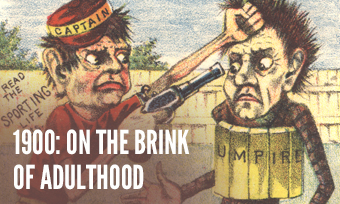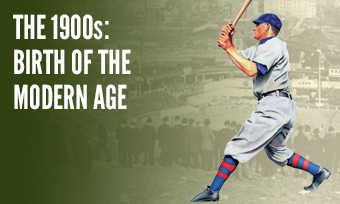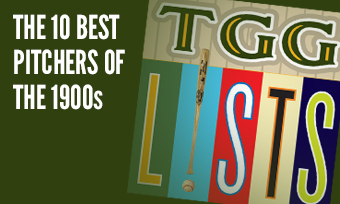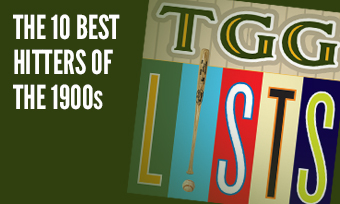The Yearly Reader
Leaders and Honors, 1900
Our list of baseball’s top 10 hitters and pitchers in the National League for the 1900 baseball season, as well as the awards and honors given to the game’s top achievers of the year.
The National League’s Top 10 Hitters, 1900
Bold type in brick red indicates league leader.
1. Honus Wagner, Pittsburgh
Key Numbers: .381 average, 107 runs, 201 hits, 45 doubles, 22 triples, 4 home runs, 100 RBIs.
Wagner saved his best for first upon arriving in Pittsburgh—setting career highs in doubles, triples and batting average.
2. Elmer Flick, Philadelphia
Key Numbers: .367 average, 106 runs, 200 hits, 11 home runs, 110 RBIs.
Flick enjoyed the best year of his brief NL tenure, though his most significant hit of the season—the one he laid on teammate Nap Lajoie in a clubhouse fight—hurt the Phillies’ pennant chances.
3. Kip Selbach, New York
Key Numbers: .337 average, 98 runs, 200 hits, 72 walks, 36 stolen bases.
A consistent .300 hitter during the 1890s, Selbach set a career high in batting average; he’d hit over .300 only once more over his next (and final) six seasons.
4. Willie Keeler, Brooklyn
Key Numbers: .362 average, 106 runs, 204 hits, 41 stolen bases.
Keeler continued to hit them were they ain’t, as reflected in his seventh consecutive year with at least 200 hits.
5. Nap Lajoie, Philadelphia
Key Numbers: .337 average, 95 runs, 33 doubles, 12 triples, 7 home runs, 92 RBIs.
Despite missing some 40 games due to his brawl with Flick, Lajoie still put together an impressive array of numbers on the eve of his massive 1901 American League debut.
6. Jesse Burkett, St. Louis
Key Numbers: .363 average, 203 hits, 15 triples, 7 home runs, 62 walks, 32 stolen bases.
Major leaguers had Burkett’s uncanny ability to foul off pitches partly to thank for the upcoming rule change charging batters with strikes on foul balls.
7. Jake Beckley, Cincinnati
Key Numbers: .341 average, 98 runs, 190 hits, 26 doubles, 10 triples, 94 RBIs.
Three years after being the last NL player until 1922 to hit three home runs in a game, Beckley only hit two for the entire 1900 season—but he did plenty of other damage with the bat.
8. Joe Kelley, Brooklyn
Key Numbers: .319 average, 90 runs, 17 triples, 6 home runs, 91 RBIs.
One of the great offensive threats of the legendary Baltimore Orioles teams during the 1890s, Kelley remained a worthy force with the Superbas.
9. John McGraw, St. Louis
Key Numbers: 99 games, .344 average, 84 runs, 85 walks, 29 stolen bases.
In his one and only year at St. Louis—and his last solely as player before his turbulent first assignment as manager for the AL’s Orioles—McGraw showed he still had plenty of gas left in the tank.
10. Billy Hamilton, Boston
Key Numbers: .333 average, 103 runs, 107 walks, 32 stolen bases.
One of baseball’s most prolific run-scorers of the 1890s—he plated nearly 200 times alone in 1894—the 34-year-old Hamilton had one last burst of excellence in his penultimate year after two injury-wracked seasons.
The National League’s Top 10 Pitchers, 1900
1. Cy Young, St. Louis
Key Numbers: 3.00 ERA, 19 wins, 19 losses, 321.1 innings, 36 walks.
Young produced a deceiving 19-19 record before jumping to better run support in the American League; it was his only sub-20-win season between 1891-1904.
2. Joe McGinnity, Brooklyn
Key Numbers: 2.94 ERA, 28 wins, 8 losses, 343 innings.
A year after winning 28 games as a 28-year-old rookie, McGinnity won 28 again—including six within a six-day period. Why doesn’t he rate higher than Young? Because he walked 113 batters and hit another 41, both NL highs.
3. Jesse Tannehill, Pittsburgh
Key Numbers: 2.88 ERA, 20 wins, 6 losses.
Not only was Tannehill stingy on the mound, but also at the plate—hitting .336 in 110 at-bats.
4. Deacon Phillippe, Pittsburgh
Key Numbers: 2.83 ERA, 20 wins, 13 losses.
Like Honus Wagner a Pittsburgh-bound refugee from the shut-down Louisville franchise, Phillippe reached 20 wins for the second time in as many seasons.
5. Rube Waddell, Pittsburgh
Key Numbers: 2.37 ERA, 8 wins, 13 losses.
It’s hard to believe that the left-handed loon led the NL in ERA despite a lowly record; maybe he would have won more had his reckless behavior not earned him a two-month suspension from Pirates manager Fred Clarke.
6. Ned Garvin, Chicago
Key Numbers: 2.41 ERA, 10 wins, 18 losses, 246.1 innings.
Not to be confused with “Fred Garvin, Male Prostitute” of Saturday Night Live fame, Ned Garvin somehow finished second behind Waddell in ERA with an even worse record.
7. Bill Dinneen, Boston
Key Numbers: 3.12 ERA, 20 wins, 14 losses, 320.2 innings.
Soon to join Cy Young with Boston’s AL entry, Dinneen certainly benefitted from the NL’s contraction—winning 20 a year after losing 20 for woebegone Washington.
8. Noodles Hahn, Cincinnati
Key Numbers: 3.27 ERA, 16 wins, 20 losses, 311.1 innings, 4 shutouts, 132 strikeouts.
Hahn set career “worsts” in ERA and losses, but the Reds weren’t complaining about his overall game in 1900.
9. Sam Leever, Pittsburgh
Key Numbers: 2.71 ERA, 15 wins, 13 losses, 232.1 innings.
After pitching 379 innings in 1899, Leever was taken off the workhorse shift by the Pirates, with optimal results.
10. Bill Carrick, New York
Key Numbers: 3.53 ERA, 19 wins, 22 losses, 45 appearances, 41 starts, 341.2 innings.
While a young Christy Mathewson bombed in his first major league audition, Giants teammate Carrick labored hard and was effective enough to keep the pitching mound warm for him.









